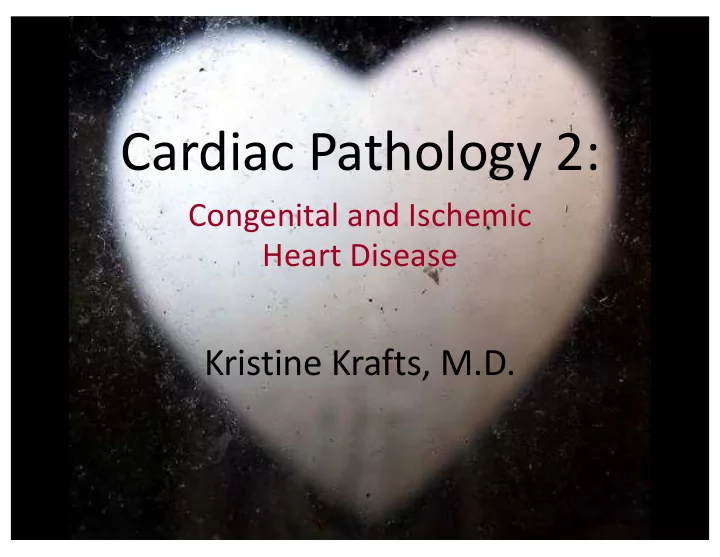

Cardiac Pathology 2: Congenital and Ischemic Heart Disease Kristine Krafts, M.D.
Cardiac Pathology Outline • Blood Vessels • Heart I • Heart II
Cardiac Pathology Outline • Blood Vessels • Heart I • Heart Failure • Congenital Heart Disease • Ischemic Heart Disease
Cardiac Pathology Outline • Blood Vessels • Heart I • Heart Failure
Heart Failure • End point of many heart diseases • Common! • 5 million affected each year • 300,000 fatalities • Most due to systolic dysfunction • Some due to diastolic dysfunction, valve failure, or abnormal load • Heart can ’ t pump blood fast enough to meet needs of body
Heart Failure • System responds to failure by • Releasing hormones (e.g., norepinephrine) • Frank-Starling mechanism • Hypertrophy • Initially, this works • Eventually, it doesn ’ t • Myocytes degenerate • Heart needs more oxygen • Myocardium becomes vulnerable to ischemia
R L
pulmonary edema hepatomegaly Main clinical splenomegaly consequences ascites of left and right heart failure peripheral edema
Left Heart Failure • Left ventricle fails; blood backs up in lungs • Commonest causes • Ischemic heart disease (IHD) • Systemic hypertension • Mitral or aortic valve disease • Cardiomyopathy • Heart changes • LV hypertrophy, dilation • LA may be enlarged too (risk of atrial fibrillation)
Left Heart Failure • Dyspnea • Orthopnea and paroxysmal nocturnal dyspnea • Enlarged heart, increased heart rate, fine rales at lung bases • Later: mitral regurgitation, systolic murmur • If atrium is big, “ irregularly irregular ” heartbeat
Right Heart Failure • Right ventricle fails; blood backs up in body • Commonest causes • Left heart failure • Lung disease ( “ cor pulmonale ” ) • Some congenital heart diseases • Heart changes • RV hypertrophy, dilation • RA enlargement
Right Heart Failure • Peripheral edema • Big, congested liver ( “ nutmeg liver ” ) • Big spleen • Most chronic cases of heart failure are bilateral
Hepatic blood flow
“ Nutmeg ” liver Nutmeg
Cardiac Pathology Outline • Blood Vessels • Heart I • Heart Failure • Congenital Heart Disease
Congenital Heart Disease • Abnormalities of heart/great vessels present from birth • Faulty embryogenesis, weeks 3-8 • Broad spectrum of severity • Cause unknown in 90% of cases
Congenital Heart Disease Left-to-right shunts • Atrial septal defect • Ventricular septal defect • Patent ductus arteriosus Right-to-left shunts • Tetralogy of Fallot Obstructions • Aortic coarctation
Left-to-right shunts Atrial Ventricular Patent septal defect septal defect ductus arteriosus
Left-to-right shunts Atrial septal defect • Small ASD: asymptomatic • Large ASD: big left-to-right shunt • Eventually, may develop Eisenmenger syndrome
Left-to-right shunts Atrial septal defect Eisenmenger syndrome: • Small ASD: asymptomatic Big left-to-right shunt puts extra • Large ASD: big left-to-right shunt pressure on pulmonary circulation. • Eventually, may develop Eventually, pulmonary vessels Eisenmenger syndrome constrict, and the shunt reverses (becomes right-to-left).
Left-to-right shunts Ventricular septal defect • Most common congenital heart anomaly • Small VSD: asymptomatic • Large VSD: big left-to-right shunt • Eventually, may develop Eisenmenger syndrome
Left-to-right shunts Patent ductus arteriosus • In utero: ductus lets blood flow from PA to aorta • After birth: ductus closes • Small PDA: asymptomatic • Large PDA: big left-to-right shunt • Eventually, may develop Eisenmenger syndrome
Right-to-left shunt Tetralogy of Fallot
Right-to-left shunt • Most common cyanotic congenital heart disease • Main problem: infundibular septum is pushed up and to the right • Four features: VSD 1. Overriding aorta 2. RV outflow obstruction 3. RV hypertrophy 4. Tetralogy of Fallot
Obstruction Coarctation of the aorta
Obstruction Coarctation of the aorta • Coarctation = narrowing • With PDA: unoxygenated blood gets dumped into aorta, causing cyanosis of lower extremities shortly after birth. • Without PDA: hypertension of upper extremities, hypotension of lower extremities; usually asymptomatic until adulthood.
Cardiac Pathology Outline • Blood Vessels • Heart I • Heart Failure • Congenital Heart Disease • Ischemic Heart Disease
Ischemic Heart Disease Myocardial perfusion can ’ t meet demand • Usually caused by decreased coronary • artery blood flow due to atherosclerosis ( “ coronary artery disease ” ) Two main clinical syndromes: angina and • myocardial infarction
How atherosclerosis leads to angina and MI Normal vessel No symptoms
How atherosclerosis leads to angina and MI Vessel <70% occluded by plaque No symptoms
How atherosclerosis leads to angina and MI Vessel >70% occluded by plaque Stable angina
How atherosclerosis leads to angina and MI Disrupted plaque Uh oh
How atherosclerosis leads to angina and MI Thrombus partially occluding vessel Unstable angina
How atherosclerosis leads to angina and MI Thrombus completely occluding vessel Myocardial infarction
Angina Pectoris Intermittent chest pain caused by • transient, reversible ischemia Stable angina • Pain on exertion • Cause: fixed narrowing of coronary artery • Unstable angina • Increasing pain with less exertion • Cause: plaque disruption and thrombosis •
Myocardial Infarction Necrosis of heart muscle caused by ischemia • 1.5 million people get MIs each year • Usually due to acute coronary artery thrombosis • sudden plaque disruption • platelets adhere • coagulation cascade activated • thrombus occludes lumen within minutes • irreversible injury/cell death in 20-40 minutes • Prompt reperfusion can salvage myocardium •
What happens to the heart after an MI? 4-12 hours 12-24 hours Days 2-7 Myocytes undergo Neutrophils arrive Macrophages come in coagulative necrosis and eat dead cells; neutrophils leave
What happens to the heart after an MI? Week 2 Weeks 3-8 Granulation tissue forms Granulation tissue replaced by collagen, forming a scar
Myocardial Infarction Clinical features Severe, crushing chest pain ± radiation • Not relieved by nitroglycerin, rest • Sweating, nausea, dyspnea • Sometimes no symptoms • Serum markers Troponins increase within 2-4 hours, • remain elevated for a week. CK-MB increases within 2-4 hours, • returns to normal within 72 hours.
Myocardial Infarction Complications contractile dysfunction • arrhythmias • rupture • chronic progressive heart failure • Prognosis overall 1 year mortality: 30% • 3-4% mortality per year thereafter •
Recommend
More recommend